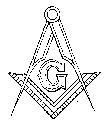Freemasonry in Depth.
According to the legends which form part of the tradition of Freemasonry, he fraternity dates back to the time of the construction of King Solomon’s Temple. This enormous structure required a highly organised workforce and led to stonemasons, architects and others, being organised into various grades or guilds, each with its own responsibilities. Towards the end of the 19th century, while excavating in the Libyan desert, the British archaeologist and Egyptologist, Sir William Petrie, unearthed papyrus records describing secret meetings around 2000 BC of such a guild. The records concerned not only matters such as working hours, wages and rules for their labour, but also the relief and assistance in distress for widows and orphans.
Of the many great buildings erected by the masons of the Middle ages, attention has focused mainly on the great cathedrals of England and Europe. To build these vast structures, it was necessary for masons to gather in large groups, which moved from one finished structure to the next one under construction. Considerable knowledge of geometry, arithmetic and engineering was necessary and these craftsmen formed themselves into guilds to maintain a level of qualification for their membership and to protect the secrets of their trade. The resulting Guild of Stonemasons became a significant centre of learning, serving not only to protect its members, but also to educate worthy apprentices and to increase the reputation of the craft.
It was not then possible to verify a man’s credentials by a union card or telephone, and signs and words were used for this purpose. Much of the work of these marvellous craftsmen survives to this day; and from it we find a living inspiration to bring similar qualities to the creation, not of material building, but of a brotherhood of men of good will.
The status and reputation of these Craft Guilds rose to such a height that it became common for leading citizens to become honorary members. They are known as ‘Speculative’ (as opposed to ‘Operative’) masons or Freemasons. As their numbers grew, and as matters concerned with education and qualification of craftsmen were formalised and controlled at a national level, so the structure of the guilds changed over the years and Lodges came to be composed exclusively of ‘Freemasons’.
What is a Lodge?
The term ‘Lodge’ has two meanings in Freemasonry. Firstly, it is used to describe the place where meetings are held. It refers to the temporary buildings erected by Masons alongside their construction projects. These were used by craftsmen as places to rest, eat, plan the projects, receive their wages and socialise. Training and education would also have taken place in the Lodge.
The second use of the term ‘Lodge’ refers to individual groups of Freemasons.
A national structure evolved for the control of these Lodges and was called the ‘Grand Lodge’. All regular Grand Lodges are lineal descendants of what are known as the ‘Mother Grand Lodges’, the United Grand Lodge of England, the Grand Lodge of Ireland and the Grand Lodge of Scotland, all three of which were established in the early seventeen hundreds.
What Happens at Lodge Meetings?
As in any organisation, the meeting is first called to order, and the ceremony of opening the Lodge is quite formal and draws on elements of the very foundations of Freemasonry. It serves to remind Freemasons of the virtues the seek to live by.
Once this is complete, minutes and correspondence are read, projects are planned, and other business taken care of, very much like any other organisation.
When new members are being received or are being advanced through the degrees of Craft Masonry, formal ceremonies are again used to teach Freemasons important moral lessons. Following the closing of the Lodge, it is usual for some socialising to take place, often over supper.


This is brilliant. Must get to meet you all for a for a drink .